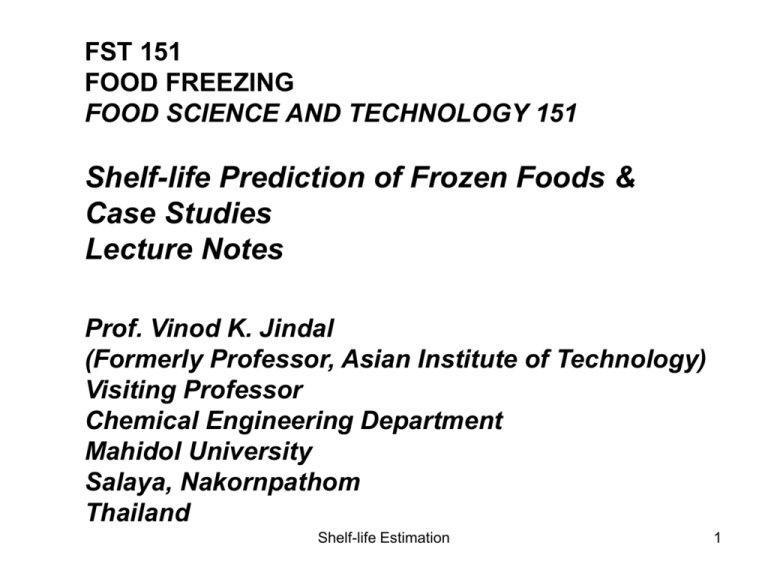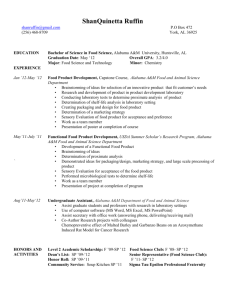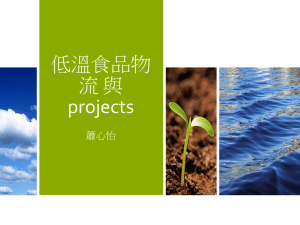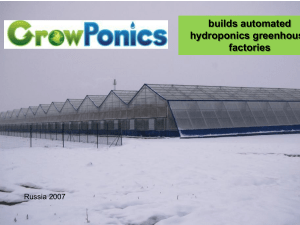Shelf-life prediction
advertisement

FST 151 FOOD FREEZING FOOD SCIENCE AND TECHNOLOGY 151 Shelf-life Prediction of Frozen Foods & Case Studies Lecture Notes Prof. Vinod K. Jindal (Formerly Professor, Asian Institute of Technology) Visiting Professor Chemical Engineering Department Mahidol University Salaya, Nakornpathom Thailand Shelf-life Estimation 1 We freeze foods to extend their storage life by making them more inert. A range of physical and biochemical reactions continues however and many of these will be influenced when storage conditions are altered. To a large extent we are unconcerned with the microbiology of frozen foods since no microorganisms grow below 10oC. The production of safe frozen foods requires the same attention to good manufacturing practice (GMP) and HACCP principles as in the case of fresh foods. Shelf-life Estimation 2 Shelf-Life Prediction of Frozen Foods Fresh or chilled foods normally have a single dominant deterioration mechanism (e.g., microbial spoilage). It is relatively easy to model the effect of temperature on the microbial growth. These models can be used to calculate when the microbial load will exceed a safe limit and thus to determine the safe shelf-life. Shelf-life Estimation 3 The prediction of the shelf-life of frozen foods is difficult because of many spoilage mechanisms present in them. These include enzymatic deterioration, cell damage and protein and starch interactions, non-enzymatic browning, water migration (both during freezing and storage), water re-crystallization and change in crystalline form, solute crystallization, oxidative deterioration (e.g., lipid oxidation in fatty meats and color changes in fish and meat), protein denaturation (which may alter water-binding capacity), and lastly, microbial changes. Shelf-life Estimation 4 Normal frozen food storage temperatures (-18 to -22oC) are significantly higher than the glass transition temperature and will consequently contain some unfrozen water. FROZEN FOODS: WHY IT IS DIFFICULT TO PREDICT SHELF-LIFE A. UNFROZEN WATER AND GLASS TRANSITION B. DETERIORATION MECHANISMS Shelf-life Estimation 5 Shelf-life Estimation 6 Shelf-life Estimation 7 Shelf-life Estimation 8 APPROACHES TO SHELF-LIFE DETERMINATION Most food engineers and technologists like to model shelflife based on the kinetics of deterioration. As most of the deterioration mechanisms in frozen foods follow either zeroorder or first-order kinetics, the modeling of shelf-life should be a simple exercise. However, the kinetic data for so many deterioration mechanisms are not easily available for the frozen food storage conditions. Additionally, many foods may undergo more than one deterioration reaction and the combined effects of these would need to be assessed. Therefore, many laboratorybased procedures have Shelf-life been Estimation introduced. 9 A. TIME TEMPERATURE TOLERANCE (TTT) The time–temperature–tolerance (TTT) experiments were introduced by the USDA laboratories in the 1960s. The assumption made for TTT experiments is that for every food there is a relationship between the storage temperature and the time taken to undergo a certain amount of quality deterioration. Such changes during storage at different temperatures are cumulative and irreversible. It is generally agreed that the most detrimental factor influencing frozen food quality is fluctuation in storage temperature and this will significantly reduce the shelf-life of the product. Shelf-life Estimation 10 B. PRACTICAL STORAGE LIFE A more commonly used descriptor was later introduced named the practical storage life (PSL). This is defined as the period of storage during which the frozen food retains its quality characteristics and is suitable for consumption. Though both the effect of temperature and food type are included for a number of food products, fluctuating storage temperatures can cause problems. Shelf-life Estimation 11 C. HIGH-QUALITY LIFE (HQL) This is the most common shelf-life determinant parameter used in the food industry. In reality, this is a time– temperature–tolerance variable but differs from the others in that sensory quality is used in its determination. It is normally defined as the time elapsed between freezing and the time when a statistically significant difference (P< 0.1) can be detected by sensory evaluation. A simpler exercise may be the determination of the elapsed time at which 70% of a trained taste panel can identify a noticeable difference between the frozen food in question and a control when using a triangular test. The control would normally have been stored at -35oC. Shelf-life Estimation 12 When different storage conditions are used during the life of the product, the HQL needs to be integrated over the different temperatures. For acceptable quality, it is essential that where tθ is the storage time at a temperature θ and HQLθ , the high-quality life at the same temperature. The values of HQLθ can be read from the chart or, alternatively, the experimental curves from which the chart was derived can be expressed in the form Shelf-life Estimation 13 Where D is analogous to the decimal reduction time in bacterial killing. It is found from two points on the semi-log plot of HQL versus θ. In fact D can be calculated as where HQLref is the high-quality life at a reference temperature θref . A typical plot from which D is derived is shown in Figure 28.1. Shelf-life Estimation 14 FIGURE 28.1 Plot of shelf-life versus temperature for a typical food. Shelf-life Estimation 15 D. ACCELERATED MEASUREMENT AND THE Q10 APPROACH The above type of plot can also be used for the so-called Q10 approach. This estimates the effect of temperature on the accelerated deterioration of shelf-life. In its simplest form, it can be expressed as the ratio of the rate of deterioration at a temperature of θ+10oC to that at a temperature of θ. Alternatively, it can be expressed as Shelf-life Estimation 16 An advantage of Q10 approach is the ability to conduct accelerated experimental shelf-life trials at elevated temperatures and then extrapolate the results to normal storage conditions. Such tests are widely used in the food industry. However, exact values of Q10 are difficult to find for many foods and approximate values are frequently used. IV. METHODS USED FOR SPECIFIC FOODS Despite the significant research efforts applied to shelflife determination of frozen foods, there is no single, universally accepted method available for application to the food industry. Th. e available data are scarce. The rate constants for the common deterioration reactions are not available for a wide range of frozen foods. Shelf-life Estimation 17





